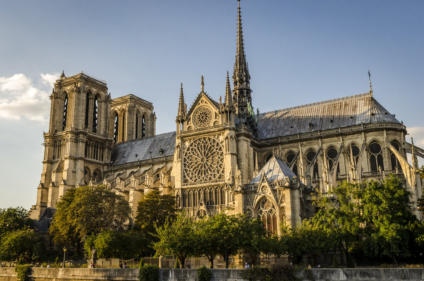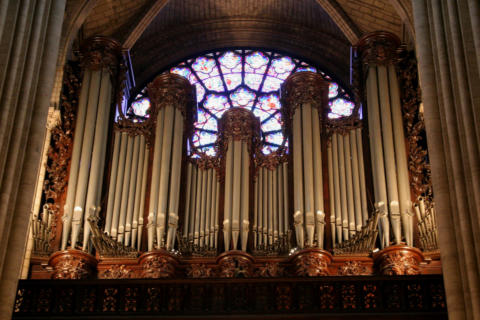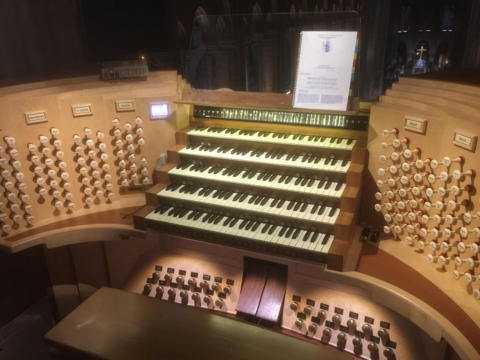


ORGANS OF PARIS © 2024 Vincent Hildebrandt HOME ALL ORGANS
Notre Dame
de Paris
6 Parvis Notre-Dame , 75004 ParisOrgue de tribune OdC >
1402 : Frederic Schambantz 1415 : Jean Chahancel 1458: Jean Bourdon 1476 Jean Robelin 1540: Pasquier Bauldry 1564 : Nicolas Dabenei 1609 et 1620 : Valeran de Hewn 1636 et 1646: Pierre Thierry 1672 : Jacques Carouge 1691: Alexandre Thierry, Hippolyie Ducastel 1699 : Jean Bessart 1733 : Francois Thierry 1783: Francois-Henri Clicquot 1812 : Pierre-Francois Dallery 1838 : Louis-Paul Dallery 1868 et 1894 : Aristide Cavaille-Coll 1904 : Charles Mutin 1932 : Societe Cavaille-Coll, Joseph Beuchet 1963 : Jean Hermann 1966: Robert Boisseau 1975 : Jean-Loup Boisseau 1992 : Boisseau, Cattiaux, Emeriau, Giroud, Societe Synaptel 2014 : Bertrand Cattiaux, Pascal Quoirin 2024 : …V/113 - electrical/digital traction - stoplist
Description of console
Video of the organ loft and console


This masterpiece of early-Gotic architecture was built
between 1163-1345, replacing a Merovingian
Cathedral, St. Stephen. During the reigns of Louis XIV
and Louis XV, the cathedral was much altered, as
Gothic style was considered outdated. During the
revolution, many of the treasures of the cathedral
were destroyed. The cathedral's organ and great bell
Emmanuel (15 th century) managed to avoid being
destructed.
The badly damaged cathedral was restored in 1845-
1870 by Lassus and Eugène Viollet-le-Duc. In fact,
quite a few parts of the present cathedral do originate
from the 19th century! From 1991 onwards, a major
program of maintenance and restoration has been
carried out. In the future, new and comprehensive
restoration works have to be carried out. Both its
exterior and its interior are overwhelming - a
maginifcent housing for its organ!
Unfortunately, the devastating fire of April, 15, 2019
did damage the home of this organ very badly. It will
be closed at least until April, 2024.


Photo: Jeroen de Haan
The first instrument is mentioned as early as 1357. In
1403, a new organ is built. Till 1730, there is a history of
many transformations and extensions. The present
organ originates from a new organ constructed by
François Thierry in 1730-33. This instrument was
renovated and extended in 1783-88 by François-Henri
Clicquot.
In 1864-68, the positive was taken away by Violet le Duc
(it is still stored somewhere in the cathedral) and the
Clicquot organ was transformed into a symphonic organ
by Cavaillé-Coll. He introduced a novelty here by
extending the harmonics using a 7th and its octaves.
In the years 1959 - 1968 the instrument was electrified ,
extended and reharmonized par Jean Hermann and
Robert Boisseau under the direction of Pierre Cochereau
and lost its symphonic character.
In 1990-92, a large-scale restoration was carried out by
Boisseau & Cattiaux, Emeriau, Giroud, returning the
organ to its symphonic character of the 19th century,
while maintaining the classical 32' grand choeur as
reconstructed in the past century.
Video: Point 'd Orgue
In 2012-2014, the organ was restorated again and
enlarged by Bertrand Cattiaux and Pascal Quoirin. They
installed a new computer traction, repaired the sunken
pipes, cleaned the organ and modified the "small pedal"
into a ‘resonnance’ board. A register system motorized
by high-pressure pneumatic actuators was supplied to
replace Cavaille-Coll's action stop ties and the pneumatic
stop tie machines were completely restored.
Video Montage and rénovation
33 stops are from before the revolution, around 50 are
from Cavaillé-Coll.
This organ is superb! Together with the great acoustiscs of
this cathedral, the organ sounds incredibly beautiful and its
power goes beyond all imagination.
April, 15, 2019
A very, very black day in the history of Paris, France and the
world: Notre-Dame-de-Paris is severly damaged by a great
fire. Thanks to the waterproof stone vault and firewall, the
great organ did not suffer! The pipes could have melted in
the fire, they are only filled with lead dust. It will take four
years to disassemble, clean and reassemble.



The old console of Cavaillé-Coll (stored in the south tower)
Organiste titulaire
Vincent Dubois, Olivier Latry, Philippe Lefebvre
Organiste titulaire émérite: Jean-Pierre Leguay
Famous organists in the past: Louis-Claude Daquin,
Claude-Bénigne Balbastre, Nicolas Séjan, Jean-Jacques
Beauvarlet Charpentier, Louis Vierne, Léonce de Saint-
Martin, Pierre Cochereau.
Videos
Olivier Latry
Vincent Dubois
Johan Vexo
Philippe Lefebvre
Jean-Pierre Leguay
Pierre Moreau
Audio
Léonce de Saint-Martin Interview
Maurice Duruflé:
... placed an a dais situated in the middle of a spacious
organ loft with thé immense nave of the cathedral in het
organist's view. Like a ship's captain on the bridge, he
takes in the great open sea. It is an absolutely
intoxicating experience.
(L'Orgue, no 162, april-june 1977)
Louis Vierne:
At Notre Dame, with the console about seven feet out
from the case, the player hears the sound directly and in
all its power. It is a joy seldom experienced elsewhere.




Pierre COCHEREAU
at the beginning of his career at NDP (since 1955)

Inauguration of the restored Great Organ, 1868
Drawing by Viollet-le-Duc


The old case of the positif,
removed by Violet-le-Duc

Organs of Paris
Notre Dame
de Paris
6 Parvis Notre-Dame , 75004 ParisOrgue de tribune OdC >
1402 : Frederic Schambantz 1415 : Jean Chahancel 1458: Jean Bourdon 1476 Jean Robelin 1540: Pasquier Bauldry 1564 : Nicolas Dabenei 1609 et 1620 : Valeran de Hewn 1636 et 1646: Pierre Thierry 1672 : Jacques Carouge 1691: Alexandre Thierry, Hippolyie Ducastel 1699 : Jean Bessart 1733 : Francois Thierry 1783: Francois-Henri Clicquot 1812 : Pierre-Francois Dallery 1838 : Louis-Paul Dallery 1868 et 1894 : Aristide Cavaille-Coll 1904 : Charles Mutin 1932 : Societe Cavaille-Coll, Joseph Beuchet 1963 : Jean Hermann 1966: Robert Boisseau 1975 : Jean-Loup Boisseau 1992 : Boisseau, Cattiaux, Emeriau, Giroud, Societe Synaptel 2014 : Bertrand Cattiaux, Pascal Quoirin 2024 : …V/113 - electrical/digital traction - stoplist
Description of console
Video of the organ loft and console

ORGANS OF PARIS © 2024 Vincent Hildebrandt ALL ORGANS

Organiste titulaire
Vincent Dubois, Olivier Latry, Philippe Lefebvre
Organiste titulaire émérite: Jean-Pierre Leguay
Famous organists in the past: Louis-Claude Daquin,
Claude-Bénigne Balbastre, Nicolas Séjan, Jean-Jacques
Beauvarlet Charpentier, Louis Vierne, Léonce de Saint-
Martin, Pierre Cochereau.
Videos
Olivier Latry
Vincent Dubois
Johan Vexo
Philippe Lefebvre
Jean-Pierre Leguay
Pierre Moreau
Audio
Léonce de Saint-Martin Interview
Maurice Duruflé:
... placed an a dais situated in the middle of a spacious
organ loft with thé immense nave of the cathedral in het
organist's view. Like a ship's captain on the bridge, he
takes in the great open sea. It is an absolutely
intoxicating experience.
(L'Orgue, no 162, april-june 1977)
Louis Vierne:
At Notre Dame, with the console about seven feet out
from the case, the player hears the sound directly and in
all its power. It is a joy seldom experienced elsewhere.
Photo: Jeroen de Haan
The first instrument is mentioned as early as 1357. In 1403,
a new organ is built. Till 1730, there is a history of many
transformations and extensions. The present organ
originates from a new organ constructed by François Thierry
in 1730-33. This instrument was renovated and extended in
1783-88 by François-Henri Clicquot.
In 1864-68, the positive was taken away by Violet le Duc (it is
still stored somewhere in the cathedral) and the Clicquot
organ was transformed into a symphonic organ by Cavaillé-
Coll. He introduced a novelty here by extending the
harmonics using a 7th and its octaves.
In the years 1959 - 1968 the instrument was electrified ,
extended and reharmonized par Jean Hermann and Robert
Boisseau under the direction of Pierre Cochereau and lost
its symphonic character.
In 1990-92, a large-scale restoration was carried out by
Boisseau & Cattiaux, Emeriau, Giroud, returning the organ
to its symphonic character of the 19th century, while
maintaining the classical 32' grand choeur as reconstructed
in the past century.
Video: Point 'd Orgue
In 2012-2014, the organ was restorated again and enlarged
by Bertrand Cattiaux and Pascal Quoirin. They installed a
new computer traction, repaired the sunken pipes, cleaned
the organ and modified the "small pedal" into a ‘resonnance’
board. A register system motorized by high-pressure
pneumatic actuators was supplied to replace Cavaille-Coll's
action stop ties and the pneumatic stop tie machines were
completely restored.
Video Montage and rénovation
33 stops are from before the revolution, around 50 are from
Cavaillé-Coll.
This organ is superb! Together with the great acoustiscs of this
cathedral, the organ sounds incredibly beautiful and its power
goes beyond all imagination.
April, 15, 2019
A very, very black day in the history of Paris, France and the
world: Notre-Dame-de-Paris is severly damaged by a great fire.
Thanks to the waterproof stone vault and firewall, the great
organ did not suffer! The pipes could have melted in the fire,
they are only filled with lead dust. It will take four years to
disassemble, clean and reassemble.





















